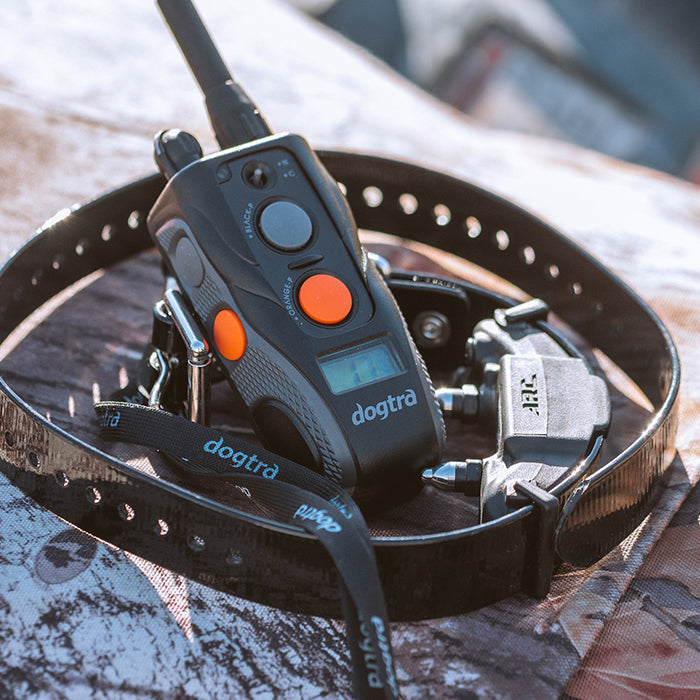DOG NOT RESPONDING TO E-COLLAR? TRY THIS!

My Dog is Not Responding to the E-Collar
You’ve purchased a Dogtra electronic collar and you give it a go! But, something just isn’t quite right. Fido isn’t responding when you press the button. Let’s examine a few things that will help you through this journey.
1. Does Your Dog Understand What You Want?
Think back to when you first put a leash on your new puppy. Remember the confusion when you tugged on the leash? You had to take the time to condition your dog to this new stimulus. Even if you didn’t realize what you were doing, you effectively trained your dog to move with the pressure applied to the leash. It took some time, but now Fido walks nicely (we’ll get to leash pulling in a later blog!) without any fuss. This is the same with an e-collar.
Before we can expect our dog to respond as you want them to you have to take the time to condition the e-collar.
- When you are first introducing your dog to the e-collar start by finding your dog’s working level. That is the lowest level of static your dog can detect.
- Once you have found that you can start to layer over the stimulation with behaviors your dog already knows.
- Ensure your dog understands the command and also understands that completing the behavior is how to turn off the stimulation.
2. Are You Using the Correct Level?
Every single factor surrounding your training session can have a direct effect on the level you must use. Take, for example, if we were in a quiet coffee shop, we could hold a conversation at a normal volume but if we go to a concert I would have to yell to get your attention. I’m not raising my voice because I’m mad at you, you simply just can’t hear me. The same goes for your dog and the level they can detect. You aren’t angry at them by raising the level, the change of environment and distractions impact their senses.
A general rule is:
- Consider your training environment. (Low Distraction VS. High Distraction)
- Dial up slowly until you get a change in your dog’s behavior.
- Assist them and remind them of the command you are asking but now you are at a level they can feel.
- Once you have your dog’s attention drop your level back down again.
Talk to many professional trainers and they will tell you: “The only thing consistent with a dogs reaction to the static stimulation from an e-collar, is that it can be very inconsistent.”
3. Do You Have a Proper Collar & Does it Fit Properly?
There are so many models of remote training collars to choose from! You want to ensure you are selecting a collar that would best suit your dog. An iQ MINI might not work on that high drive Boarder Collie bent on herding your children. Just like the ARC isn’t meant for the 7-pound Chihuahua yapping at the Amazon driver. Check out Dogtra’s e-collar finder to get a better idea of what unit would work best for you.
Tips for proper e-collar fit:
- Size of collar appropriate for your dog’s weight and neck size
- You want your collar to be snug but not too tight.
- The collar should stay put and not be able to easily turn around your dog’s neck.
- Contact points should be reaching through the hair and making contact with your dog’s skin.
- Test Your E-Collar
If you are still unsure if your unit is working properly, you can test the unit off the dog to verify consistent stimulation.
Here are two methods:
WATCH: HOW TO TEST TUTORIAL HERE
Test Light:
- The test light is a plastic cap that came with your original Dogtra system.
- Press and place the cap over the two contact points.
- Pressing the Continuous button slowly increase the stimulation.
- Stimulation will emit a light on your test light becoming brighter or dimmer as you increase and decrease stimulation.
Self-Test:
- If you do not have a test light you may test on your inner wrist for best sensation.
- Rest your wrist on the receiver so both contact points make contact on your skin.
- Start at a level 5 and slowly dial up until you feel the static sensation.
Be aware that many people and dogs, do not react to the same levels. Your felt level may be higher or lower than your dogs. The purpose of testing is to verify your unit is producing consistent stimulation.
5. Make Sure E-Collar is Charged
Be sure that your e-collar has been properly charged and the battery life indicator light is green. A weak battery will equate to inconsistent stimulation and range.
How Cortisol Levels Can Influence Dog’s Response to E-Collar
Cortisol, a hormone produced by the adrenal gland in response to stress, can cause a range of physiological and behavioral changes in dogs. When dogs are exposed to an e-collar, they may experience significant stress levels that result in increased cortisol. High levels of cortisol can lead to increased anxiety, fear, and aggression in dogs, which may cause them to respond negatively to the e-collar. Moreover, dogs that already have anxiety or fear-related issues are more susceptible to the negative effects of elevated cortisol caused by e-collar use. As a result, it is important for dog owners to consider the potential impact of cortisol levels on their dog's response to e-collar training and to explore alternative training methods when appropriate.
Final Thoughts
In conclusion, there are several reasons why a dog may not respond to an e-collar. It is important for dog owners to recognize that an e-collar is not a magic tool and may not be suitable for every dog. The most common reasons for e-collar failure include incorrect use, poor fit, lack of proper training, and underlying medical issues. If a dog is not responding to an e-collar, it is important to rule out any medical issues and seek the help of a professional dog trainer who can help identify and address any training or behavioral issues. With proper use and training, an e-collar can be an effective tool for many dogs, but it should always be used with caution and under the guidance of a professional. Ultimately, it is up to the dog owner to determine if an e-collar is the right tool for their dog's individual needs and to use it responsibly and with the well-being of the dog as the top priority.





